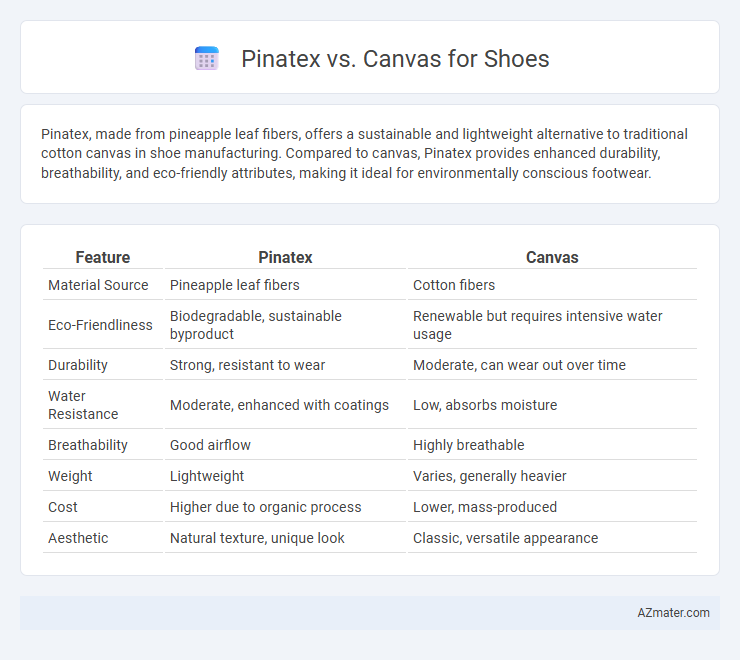Pinatex, made from pineapple leaf fibers, offers a sustainable and lightweight alternative to traditional cotton canvas in shoe manufacturing. Compared to canvas, Pinatex provides enhanced durability, breathability, and eco-friendly attributes, making it ideal for environmentally conscious footwear.
Table of Comparison
| Feature | Pinatex | Canvas |
|---|---|---|
| Material Source | Pineapple leaf fibers | Cotton fibers |
| Eco-Friendliness | Biodegradable, sustainable byproduct | Renewable but requires intensive water usage |
| Durability | Strong, resistant to wear | Moderate, can wear out over time |
| Water Resistance | Moderate, enhanced with coatings | Low, absorbs moisture |
| Breathability | Good airflow | Highly breathable |
| Weight | Lightweight | Varies, generally heavier |
| Cost | Higher due to organic process | Lower, mass-produced |
| Aesthetic | Natural texture, unique look | Classic, versatile appearance |
Overview: Piñatex and Canvas Materials
Pinatex is an innovative, sustainable material made from pineapple leaf fibers, offering a lightweight, breathable, and eco-friendly alternative for shoe manufacturing. Canvas, traditionally crafted from cotton or hemp, provides durability, flexibility, and a classic texture widely used in casual footwear. Comparing Pinatex and canvas reveals key differences in environmental impact, material strength, and aesthetic appeal, influencing consumer choices in sustainable and traditional shoe options.
Sustainability and Eco-Friendliness
Pinatex, made from pineapple leaf fibers, offers a sustainable alternative to traditional canvas by utilizing agricultural waste, reducing resource consumption, and minimizing environmental impact. Canvas, typically derived from cotton, involves intensive water use and pesticide application, raising concerns about its eco-friendliness despite being biodegradable. Choosing Pinatex for shoes supports circular economy principles and lowers carbon footprint, aligning better with sustainable fashion goals.
Durability Comparison
Pinatex, made from pineapple leaf fibers, offers remarkable durability with high tensile strength and resistance to wear, making it a sustainable alternative to traditional canvas. Canvas shoes, crafted from cotton or linen, are known for their breathability and flexibility but tend to wear out faster under heavy use. In terms of durability, Pinatex outperforms canvas by providing enhanced abrasion resistance and longevity, especially in outdoor or high-activity conditions.
Comfort and Breathability
Pinatex, made from pineapple leaf fibers, offers natural breathability and lightweight comfort, making it an eco-friendly alternative to traditional canvas. Canvas, typically a cotton fabric, provides flexibility and good breathability but may retain moisture more than Pinatex, affecting overall comfort. Shoes crafted from Pinatex tend to maintain airflow and reduce sweat buildup, enhancing comfort during extended wear.
Design and Aesthetic Flexibility
Pinatex offers a unique, sustainable alternative to traditional canvas with its natural pineapple leaf fibers, providing a distinctive texture and organic appearance that enhances shoe design originality. Canvas is celebrated for its smooth, uniform surface that enables a wide range of colors and intricate prints, allowing extensive aesthetic customization. Both materials support versatile design applications, but Pinatex appeals to eco-conscious brands seeking innovation, while canvas remains a classic choice for vibrant, adaptable styles.
Water Resistance and Weather Performance
Pinatex, made from pineapple leaf fibers, offers moderate water resistance but can degrade when exposed to prolonged moisture, making it less ideal for wet weather. Canvas is more durable in wet conditions, drying faster and resisting water absorption better, but it lacks the inherent water-repellent properties of treated synthetic materials. For footwear subjected to frequent rain or humidity, canvas provides superior weather performance compared to untreated Pinatex.
Cost and Affordability
Pinatex, derived from pineapple leaf fibers, offers a sustainable and eco-friendly alternative to traditional canvas but tends to be priced higher due to its innovative production process and limited-scale manufacturing. Canvas, made from cotton or linen, is widely available, cost-effective, and easier to produce, making it the more affordable option for mass-market shoe production. Price sensitivity and budget constraints in footwear manufacturing often lead brands to choose canvas over Pinatex despite its environmental benefits.
Maintenance and Cleaning
Pinatex shoes require gentle cleaning with a soft brush or damp cloth to preserve the natural pineapple fibers, avoiding harsh chemicals that can damage the material's texture. Canvas shoes are more durable in terms of cleaning, often machine washable or easily scrubbed with soap and water, making them highly practical for everyday maintenance. Both materials benefit from air drying and occasional protective sprays to extend their lifespan and maintain appearance.
Ethical Considerations in Production
Pinatex, derived from pineapple leaf fibers, offers a sustainable alternative to traditional canvas by utilizing agricultural waste, reducing environmental impact and promoting circular economy principles. Canvas production often relies on cotton, which requires significant water and pesticide use, raising concerns about resource depletion and ecological harm. Ethical considerations favor Pinatex for supporting eco-friendly agriculture and fair labor practices within pineapple farming communities.
Final Verdict: Which Material is Better for Shoes?
Pinatex offers a sustainable and eco-friendly alternative to traditional canvas for shoes, made from pineapple leaf fibers that provide durability and breathability. Canvas remains a popular choice due to its lightweight, flexibility, and affordability, making it ideal for casual footwear. When prioritizing environmental impact and unique texture, Pinatex is better, whereas for cost-effectiveness and classic style, canvas remains the preferred material.

Infographic: Piñatex vs Canvas for Shoe
 azmater.com
azmater.com